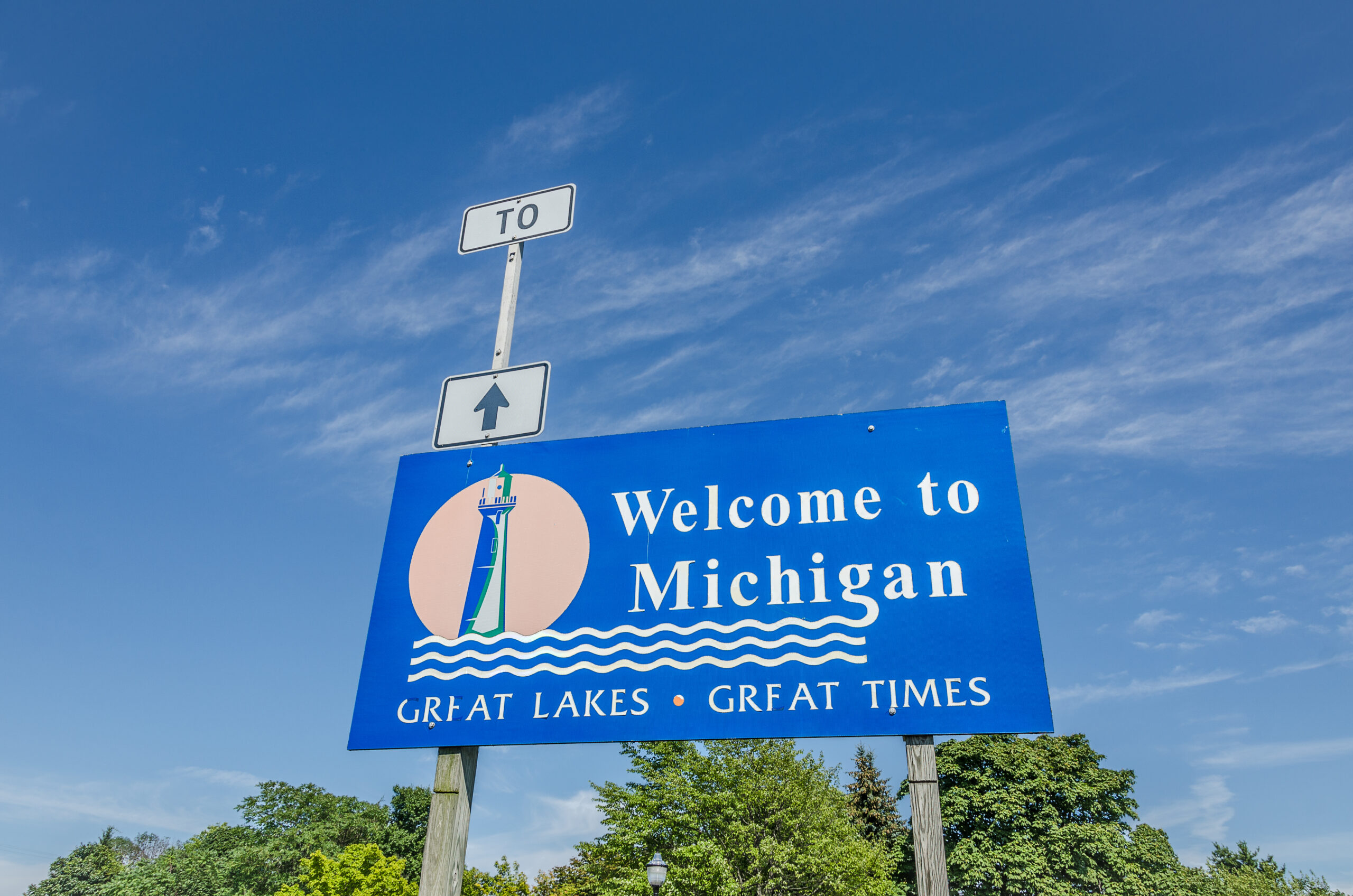Michigan is a state carved by water — held, surrounded, nourished, and defined by it. The Great Lakes bend around its peninsulas like open arms, shaping not only its geography but its identity. Here, the horizon is often a line of blue, the wind carries the faint scent of freshwater, and life has always moved to the rhythm of waves meeting shore. It is a place where nature does not simply decorate life — it directs it.
To travel through Michigan is to feel the vastness of the continent itself. The Upper Peninsula stretches wild and unyielding, forests thick as folklore and cliffs plunging into the cold, clear waters of Lake Superior. The Lower Peninsula, often called “the mitten,” unfurls in rolling orchards, quiet inland lakes, cherry farms, college towns, and cities that have risen, fallen, and risen again with the force of reinvention.
Michigan is a state of contrasts — northern stillness and southern bustle, industrial heritage and untouched wilderness, snowbound winters and sunlit summers. Detroit’s skyscrapers glow with a renewed hum of innovation, while Mackinac Island drifts in a Victorian dreamscape untouched by automobiles. Lighthouses stand sentinel along two thousand miles of shoreline, each a reminder of the storms that shaped the Great Lakes and the people who navigated them.
The forests whisper with legends of lumberjacks and voyageurs. The lakes sparkle with the memory of steamboats and schooners. The cities pulse with jazz, automotive genius, and the unmistakable sound of Motown.
And everywhere, there is water — reflecting sky, softening landscape, reminding you that Michigan’s soul is fluid, resilient, and endlessly renewing.
To know Michigan is to experience abundance: of nature, of creativity, of spirit. It is to drive a highway lined with cherry trees in bloom, to hear loons calling across a glassy lake at dusk, to walk a dune ridge above an inland sea, to feel the grit and pride of a state that has reinvented itself more than once.
This is Michigan — vast, diverse, beautiful, and profoundly American.
A land shaped by water, memory, and hope.
A place that invites you to wander, listen, and stay awhile.
Detroit: The City That Refuses to Quit

Detroit is not merely a city — it is a testament to reinvention. Few American places have fallen so far, fought so fiercely, or risen so defiantly. Here, resilience is not an idea; it is the local currency.
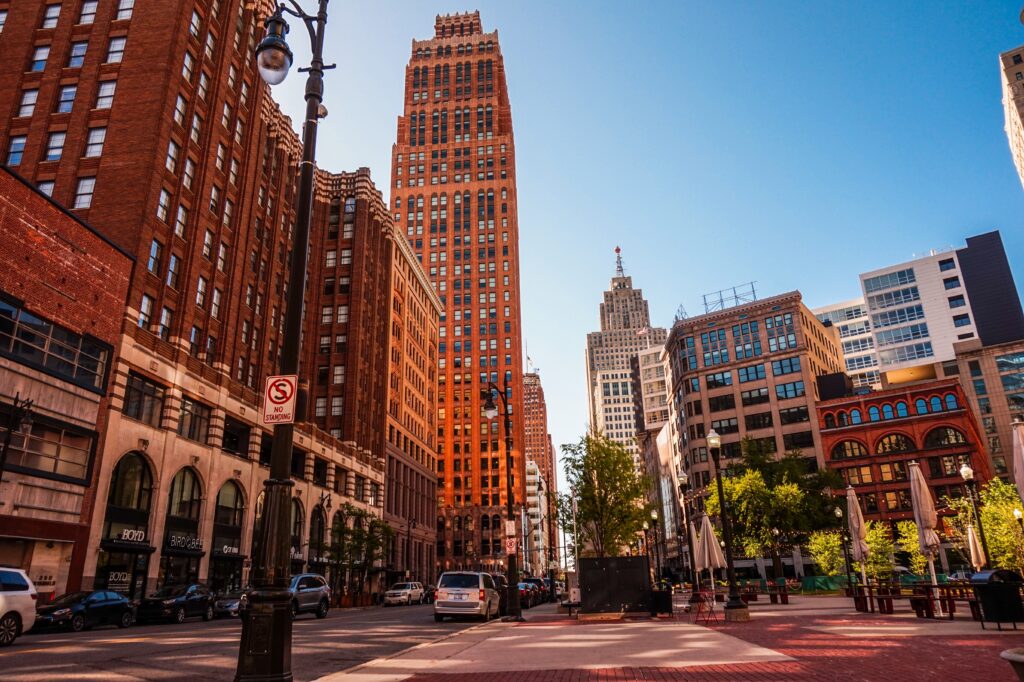
Walk through Downtown Detroit, and you feel its pulse: the Art Deco brilliance of the Guardian Building, the reborn Fox Theatre, the kinetic energy of Campus Martius where people cluster even in winter, warmed by fire pits and urban pride.
Detroit is the birthplace of the automobile, where Henry Ford’s audacity changed the world. The Ford Piquette Avenue Plant still stands, a cathedral of industry where the first Model Ts rolled into history.

But Detroit’s soul is musical. In a modest house on West Grand Boulevard, Motown began — a sound that reshaped global culture. The Motown Museum feels sacred, its wood floors still carrying the faint echo of basslines and harmonies that brought joy to generations.
Today, artists, chefs, and innovators are breathing fresh life into every neighborhood. Corktown’s restaurants feel like community living rooms. Midtown’s galleries pulse with new vision. Eastern Market, one of the oldest public markets in the country, spills over with produce, murals, and humanity.
Detroit’s power lies not in perfection but in its authenticity — its willingness to face the truth and build something better from it. This is a city that has weathered storms and still finds a way to sing.
Ann Arbor: Intellectual Warmth and Creative Flow

Ann Arbor is a city that feels both youthful and wise, a place where ideas drift through the air like leaves in autumn. Anchored by the University of Michigan, it vibrates with curiosity — students on bicycles, jazz drifting from open cafés, bookstores stacked with voices old and new.
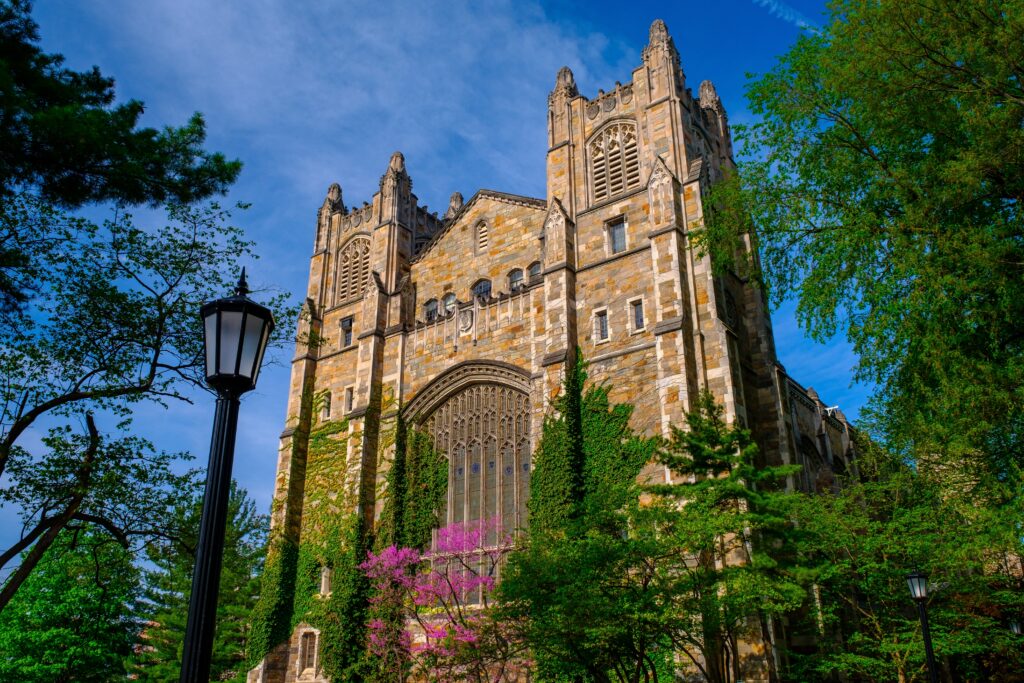
The university’s campus blends Gothic architecture with cutting-edge labs, reminding you that Ann Arbor is always balancing tradition and innovation. The Law Quadrangle, with its stone arches and quiet courtyards, feels like stepping into a European cloister.
Yet Ann Arbor is not solemn. Its streets buzz with art, activism, and culinary adventure. The Kerrytown Market brings fresh produce, musicians, and bakers together in a swirl of color. Iconic places like Zingerman’s are not just restaurants — they’re cultural institutions fueled by passion and community.
The city’s parks weave through it like green veins. The Huron River curls gently along picnic grounds and kayak launches, offering a soft counterpoint to the intellectual intensity downtown. In spring, magnolia blossoms unfurl along residential streets, carrying a sweetness that feels almost like memory.
Ann Arbor invites conversation — about books, justice, technology, or the meaning of a well-made cup of coffee. It is a place where people care deeply, dream boldly, and believe fiercely in possibility.
Mackinac Island: A Victorian Dream Floating on Blue Water
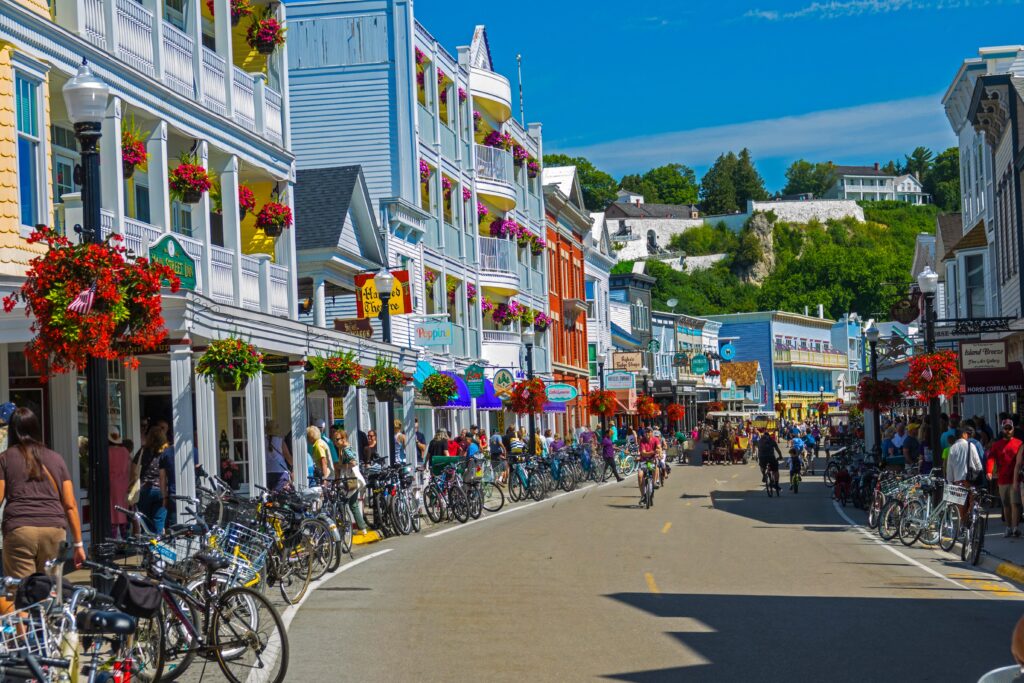
There is nowhere in America quite like Mackinac Island, a place suspended between centuries, where the clip-clop of horse hooves replaces the hum of engines. Cars are banned here; time moves with the rhythm of bicycles and carriages.

Approaching the island by ferry, its limestone bluffs rise from the water like a storybook brought to life. The Grand Hotel, with its sweeping porch and white-columned elegance, stands high above the shoreline, looking out over a horizon that seems to stretch forever.

Wander the streets and you’ll smell fresh fudge cooling in shop windows — a ritual as iconic as the island itself. Trails wind into cedar forests and up to Arch Rock, a natural stone arch carved by wind and waves over centuries. The views are sweeping: Lake Huron shimmering below like a sheet of glass.
Mackinac Island is small, but it contains multitudes — quiet beaches, hidden gardens, military history at Fort Mackinac, and sunset spots that turn the world gold.
Here, life feels gentler. Summer evenings linger. Conversations stretch. Time slows until you understand why people return year after year. Mackinac is not just an island — it is an escape, a memory in motion, a reminder of what stillness can offer.
Sleeping Bear Dunes: Where Land Meets Sky in a Miracle of Sand

Sleeping Bear Dunes National Lakeshore is one of the most astonishing landscapes in America — a world where wind, water, and time have sculpted a dreamscape of towering sand, turquoise shallows, and endless sky. Standing atop the 450-foot dune cliffs above Lake Michigan, you feel as if you’ve reached the edge of something both ancient and eternal. The view is pure blue infinity, the horizon dissolving into whatever the imagination wants it to be.
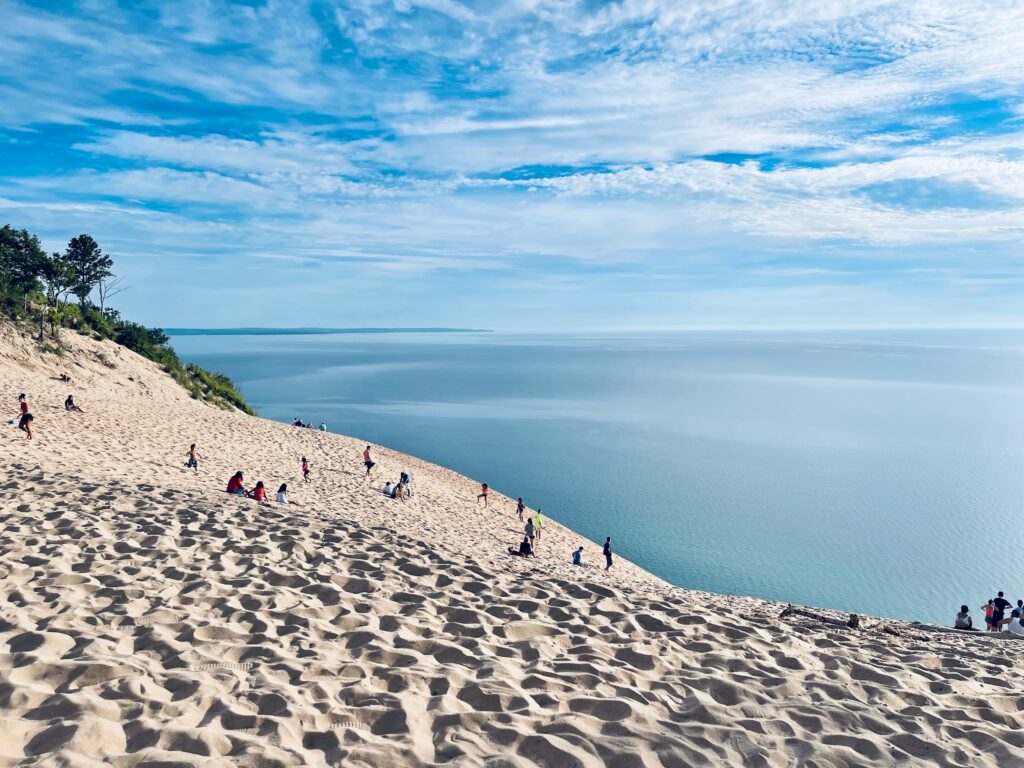
The dunes shift under your feet, warm in the sun, cool beneath the surface. Trails snake through forests of sugar maple and beech before opening suddenly into vast sandscapes that seem to belong to another planet. The famous Dune Climb is a rite of passage: each step is a test, each view a reward.

Out on the water, the Manitou Islands rise in misty silhouettes — remote, mythic, and wild. Their beaches feel untouched, their forests whispering with a depth of stillness that modern life rarely allows.
In nearby Glen Arbor and Empire, life carries the gentle rhythm of small lake towns: art galleries, ice-cream shops, cyclists weaving toward the shoreline, kayakers gliding through the Crystal River. Evening comes with a softness here. Sunsets unfurl in ribbons of gold and coral, washing the dunes in a glow that makes them seem alive.
Sleeping Bear is more than scenery. It is a place that quiets the mind, lifts the spirit, and reminds you how beautiful the meeting of land and water can be.
Traverse City: Cherries, Shorelines, and the Art of Slow Living

Traverse City is Michigan’s bright-eyed summer capital — a place where cherry blossoms paint the hillsides pink, sailboats drift across Grand Traverse Bay, and evenings stretch long with the scent of lake breeze and outdoor dining. It is a city that balances everything gracefully: culture and calm, family-friendly charm and gourmet sophistication, sandy beaches and rolling vineyards.

Spring arrives with a whisper — orchards blooming across the Old Mission and Leelanau peninsulas, turning the landscape into a delicate watercolor of white and rose. By summer, the region is bursting with life. The National Cherry Festival fills the streets with laughter, parades, and the sweet tang of fresh pies.
Downtown Traverse City feels lively yet intimate: independent bookstores, cafés spilling onto sidewalks, craft breweries, and a food scene that punches far above its size. The restored State Theatre, brought back to life under filmmaker Michael Moore, glows like a jewel at night.
Venture out along the Old Mission Peninsula, and vineyards unfurl toward the water, offering some of the most scenic wine country vistas in the Midwest. Tasting rooms sit perched above cliffs, their decks overlooking miles of blue water as serene as any Mediterranean coast.
Traverse City is also a gateway. In minutes, you can reach hidden coves, sandy trails, cedar forests, and the immense beauty of Sleeping Bear Dunes. Life here feels balanced — full but unhurried, refined but warmly welcoming.
Grand Rapids: Creativity Rising Along the River

Grand Rapids is Michigan’s quiet powerhouse — a city where creativity, craft, and community converge along the banks of the Grand River. Once known primarily for its furniture factories, it has transformed into a thriving hub of art, innovation, and culture while keeping its Midwestern warmth intact.
Downtown is bright with murals, sculptures, and public art installations — many a result of ArtPrize, one of the largest open art competitions in the world. This event turned the entire city into a gallery, and its spirit lingers year-round: creativity here is not confined to museums; it lives in the streets.
Grand Rapids is also a titan of craft brewing. Dozens of breweries line its neighborhoods, each with its own personality — from cozy, wood-paneled taprooms to ambitious experimental brew houses. Locals don’t just drink beer; they celebrate it, discuss it, and perfect it.

The Frederik Meijer Gardens & Sculpture Park is one of Michigan’s cultural crowns — a vast oasis of botanical beauty paired with world-class sculpture. Wandering through its peaceful trails and reflecting pools feels like slipping into an outdoor cathedral of nature and art.
The river itself is central to the city’s identity. Plans to restore the Grand River’s original rapids have energized locals, who see the waterway not as a barrier but as a future gathering point for recreation and community life.
Grand Rapids is confident but humble, lively yet grounded. It’s a place where creativity grows easily — watered by the river, supported by community, and encouraged by a city that believes deeply in reinvention.
Pictured Rocks National Lakeshore: A Cathedral of Color on Lake Superior

Along the remote coast of Lake Superior, Pictured Rocks National Lakeshore rises like a natural masterpiece — a stretch of sandstone cliffs carved and painted by centuries of wind, waves, and slow geological poetry. Here, Michigan feels wild in a way that borders on myth. The lake is vast and fierce, its cold waters churning against cliffs streaked in shades of emerald, gold, russet, and turquoise.
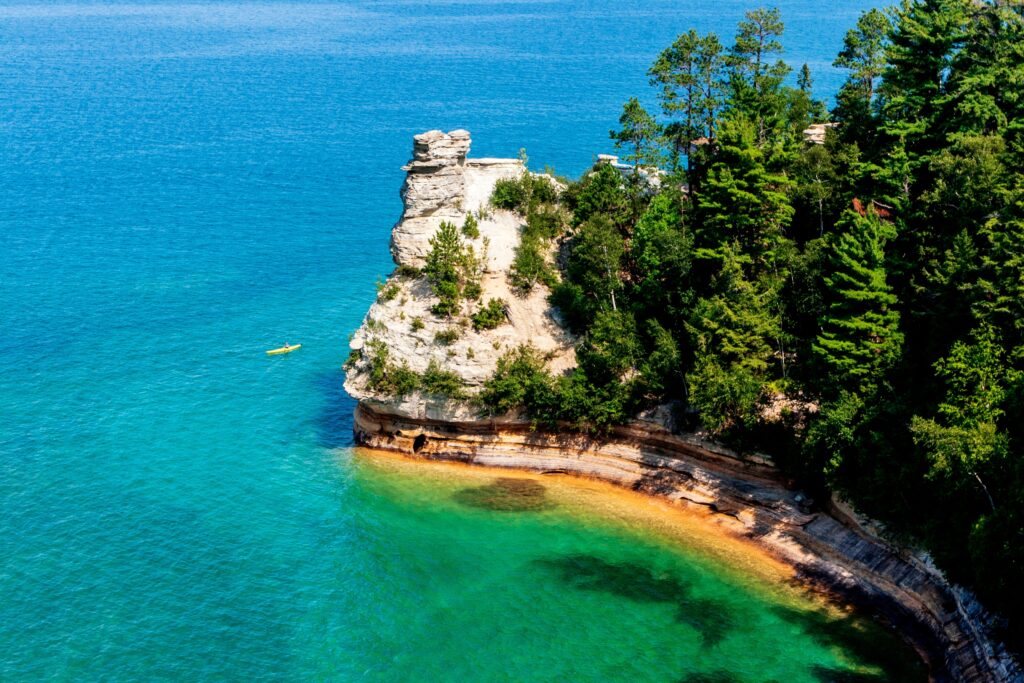
The sight of Miners Castle, its formations sculpted by time, feels like something you might find in an ancient coastal kingdom. Sea caves echo with waves; waterfalls tumble directly into the lake; and hidden beaches glow with stones polished smooth by Superior’s relentless energy.
Kayakers glide along the cliffs, their paddles silent against the water’s deep blue. Hiking trails weave through dense forests of birch and pine, opening suddenly onto overlooks where the cliffs drop steeply into crystalline water. The scale is immense yet intimate — a wilderness that invites exploration but insists on respect.
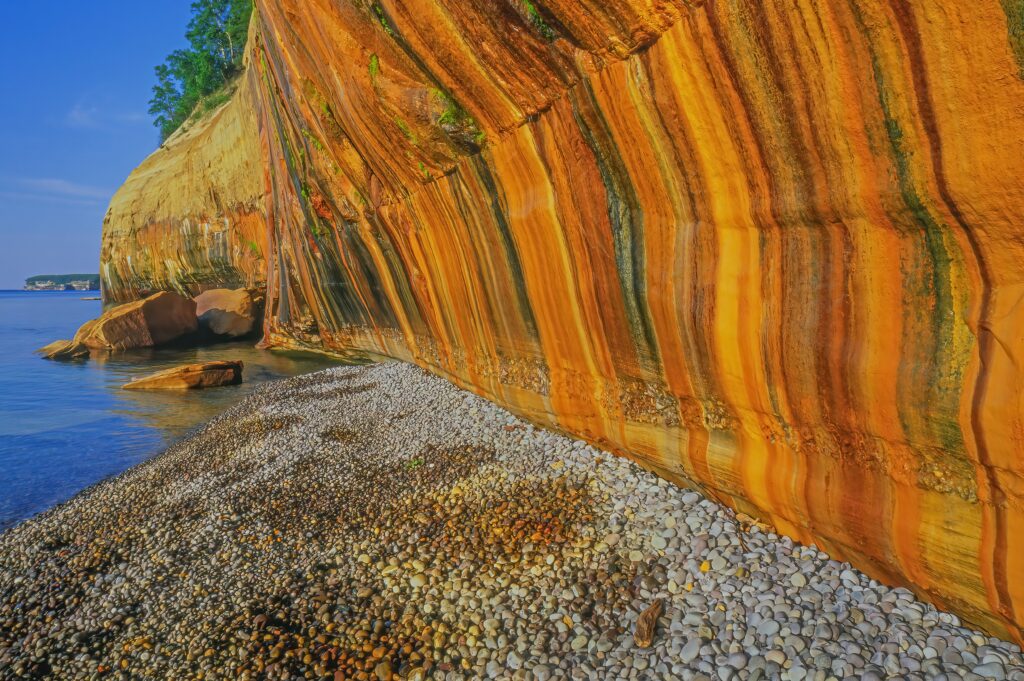
In every season, Pictured Rocks offers a different face. Summer is vibrant, buzzing with adventurers. Autumn is fiery, the trees blazing across the hillsides. Winter turns the cliffs into frozen cathedrals of ice, blue and translucent, like something forged in a dream.
The nearby town of Munising feels small and welcoming — the kind of place where outfitters help you plan your route and cafés warm you after long hikes. Pictured Rocks is not merely beautiful; it is elemental, a reminder of nature’s incredible patience and power.
The Upper Peninsula: Wilderness, Waterfalls, and the Soul of the North
The Upper Peninsula — affectionately “the U.P.” — is a world apart from the rest of Michigan. It feels wilder, older, quieter. Forests stretch for miles without interruption, lakes reflect skies untouched by city lights, and every road seems to lead toward something rugged and real.
The U.P. is shaped by extremes. Winters are fierce, sculpting the landscape in ice and silence. Summers are gentle and golden, full of long days that seem to last forever. Along the coasts of Lake Superior, waves crash with oceanic power, sending mist into the air with a cold bite even on warm days.

Waterfalls are everywhere — more than 300 of them — tumbling through cedar groves and rocky gorges. Tahquamenon Falls, the largest and most iconic, roars with a coppery force, tinted by the tannins of northern forests. Nearby, the town of Paradise lives up to its name with quiet beaches and sweeping views.
The U.P. is also rich with history: old copper mines, ghost towns reclaimed by nature, lighthouses standing solitary against the elements. Wildlife thrives here — moose, black bears, pine martens, even the occasional wolf.

Small towns like Marquette, Houghton, and Copper Harbor offer warmth in the vastness: breweries pouring local ales, cafés serving pasties, and people who greet strangers like neighbors. The night skies are spectacular — stars sharp and numerous, the Milky Way visible in a way most Americans never see. Sometimes, if you’re lucky, the Northern Lights ripple across the horizon in green and violet curtains.
The U.P. is Michigan’s great frontier — a place not just to visit, but to feel deeply.
Mackinaw City & the Straits: Winds, Water, and the Gateway to the North

Mackinaw City stands at one of the great crossroads of North America — where Lake Michigan meets Lake Huron, where the Lower Peninsula gives way to the Upper, and where the vast, elegant sweep of the Mackinac Bridge carries travelers across one of the most storied stretches of water in the country. The Straits are living water — always moving, shifting, sparkling, and alive with history.
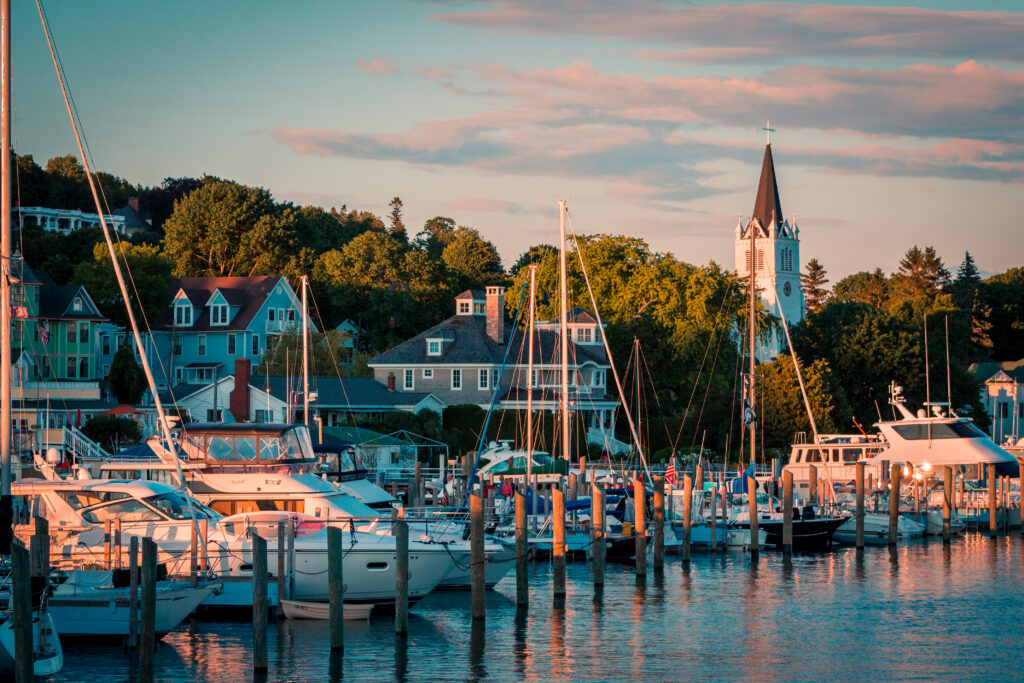
The town itself feels like a place built on hospitality. Ferries glide out toward Mackinac Island. Families wander between fudge shops, ice-cream stands, and scenic docks. Yet beneath the lighthearted charm runs a deeper story: Indigenous trade routes, French voyageurs, the early fur economy, and the turbulent contests that shaped America’s frontier.

Fort Michilimackinac, reconstructed with loving detail, brings 18th-century life vividly to the present. Actors in period clothing fire muskets, bake bread, and interpret daily life in a place once vital to colonial ambitions. Sunset at the fort — the lake glowing gold, the bridge standing tall in silhouette — feels almost cinematic.
But the real soul of Mackinaw City lies in its setting. The winds carry the scent of pine and freshwater. Gulls wheel overhead. The bridge hums softly, a 5-mile ribbon of steel connecting two worlds. Standing at the shoreline, looking across the Straits, you feel Michigan’s grand geography come into focus.
Mackinaw City is not just a destination — it’s the threshold to journeys, a place defined by movement, passage, and the beauty of connection.
Holland: Tulips, Windmills, and the Warm Glow of Dutch Heritage
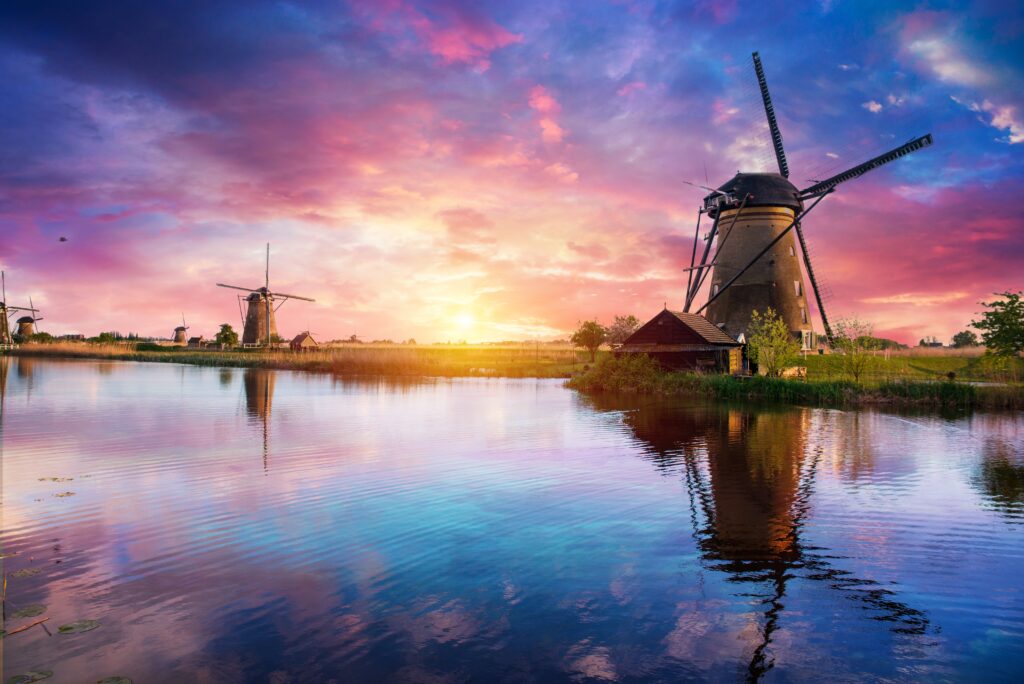
Holland feels like stepping into a storybook — one stitched together with colorful tulip fields, sandy lake beaches, and the Old World charm of a town that cherishes its Dutch heritage with genuine affection. In spring, it becomes one of the most spectacularly colorful places in America. Millions of tulips bloom across parks, neighborhoods, and festival grounds, transforming the landscape into a patchwork of vibrant reds, purples, yellows, and creams.
The Tulip Time Festival, held each May, is the heart of the town’s identity — parades of dancers in wooden shoes, artisan markets, traditional music, and the cheerful sense that the whole community is celebrating the simple joy of beauty returning to the world after winter.

Yet Holland’s appeal lasts long after the flowers fade. The downtown is lively and impeccably kept, its sidewalks heated in winter so that snow melts away — a thoughtful innovation that keeps the heart of the city walkable year-round. Boutiques, cafés, breweries, and galleries line the streets, blending European coziness with modern flair.
To the west, Lake Michigan offers the perfect complement to the town’s cultural charm. Holland State Park is a beloved expanse of wide sandy beach, framed by the red silhouette of the iconic Big Red Lighthouse, which stands across the channel like a sentinel of the shore. Sunsets here burn spectacularly, the lake turning molten gold before fading into warm twilight.
Holland is a gentle surprise — a place where heritage, creativity, and natural beauty intermingle, creating a uniquely welcoming spirit.
Petoskey: Stones, Sunsets, and the Romance of Little Traverse Bay

Petoskey sits along one of the most beautiful stretches of shoreline in the Great Lakes — a place where Little Traverse Bay curves inward like a protective cradle, where water meets forest in deep greens and shimmering blues. The town is elegant yet unpretentious, its Victorian architecture softened by a breezy lakeside ambiance that makes visitors feel instantly at ease.
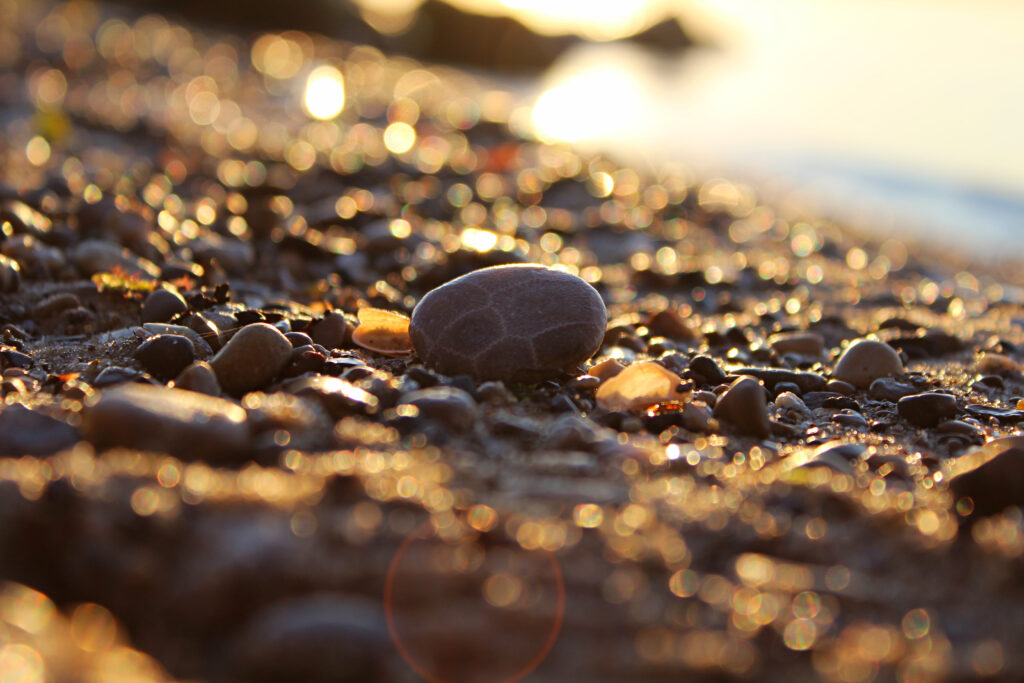
The region is famous for its Petoskey stones, fossilized coral fragments that wash ashore displaying honeycomb patterns when wet. Searching for them along the beaches becomes a meditative ritual — kneeling in the surf, sifting through stones, waiting for sunlight to reveal the unexpected beauty beneath the surface.

Downtown Petoskey is a delight: bookshops and boutiques housed in historic buildings, streets lined with cafés, wine bars, and the cozy charm of a small town that values art, conversation, and community. Ernest Hemingway spent summers nearby, and the area retains the sense of quiet inspiration that once fueled his early stories.
Beyond the town center, rolling hills give way to forests, bike trails, and scenic overlooks. The nearby communities of Harbor Springs and Bay Harbor add to the bay’s refined atmosphere, offering marinas, golf courses, and waterfront paths ideal for leisurely afternoons.
In summer, the bay glows turquoise, sailboats drifting lazily across its calm surface. In autumn, the hills blaze with color; in winter, the town becomes a peaceful snow globe beneath the quiet drift of lake-effect flakes.
Petoskey is a place defined by subtle elegance — natural beauty, cultural warmth, and the quiet romance of the northern lakes.
Frankenmuth: Bavaria Reimagined in the American Midwest

Frankenmuth is a place where nostalgia, charm, and cultural heritage combine to create something delightfully singular. Known fondly as “Michigan’s Little Bavaria,” it welcomes visitors with timber-framed architecture, flower-lined streets, and the warm scent of fresh pretzels drifting from bakery doors. The atmosphere is cheerful without being kitschy — an American town that lovingly celebrates its German roots while still feeling completely at home in the Great Lakes.

The Frankenmuth River Place Shops evoke an alpine village, where families stroll with ice creams, musicians perform polka tunes, and boutiques sell everything from artisan chocolates to hand-crafted ornaments. The Cass River drifts gently through the center of town, its covered wooden bridge — the Zehnder’s Holz Brücke — lending the cityscape a touch of European romance.
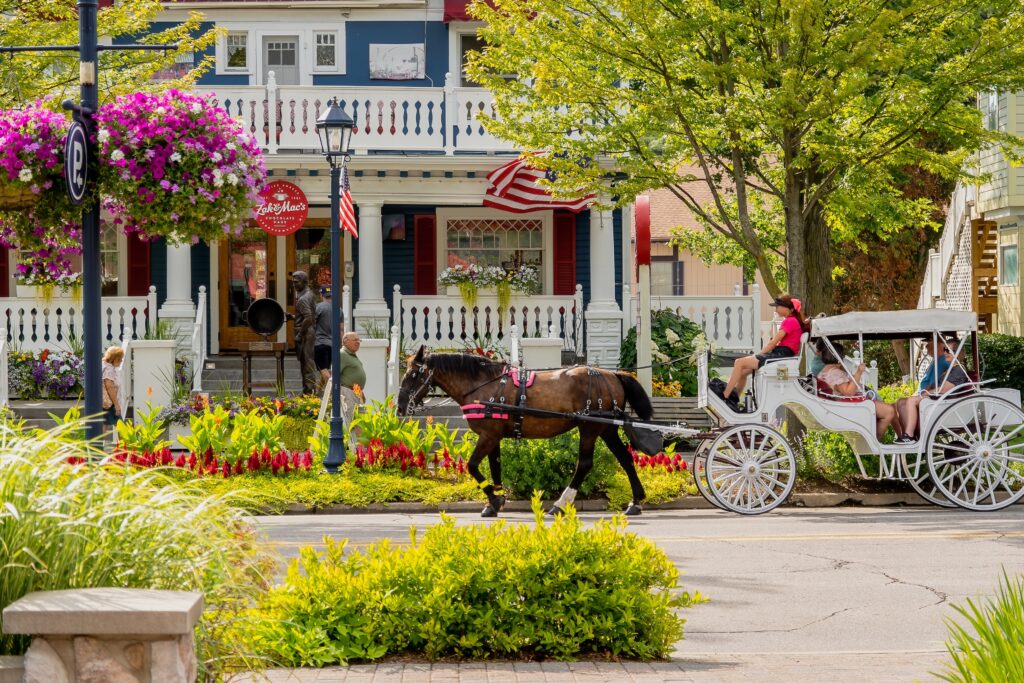
Frankenmuth’s culinary fame, however, is legendary. Zehnder’s and the Bavarian Inn serve their iconic family-style chicken dinners, complete with homemade breads, creamy mashed potatoes, and Michigan-grown vegetables. Meals here feel like tradition more than dining — long tables, shared dishes, and a sense that everyone is celebrating together.
The town’s festive spirit reaches its peak at Bronner’s Christmas Wonderland, the world’s largest Christmas store, glowing year-round with ornaments, twinkling lights, and holiday music. In winter, the whole town shines — wreaths hanging from lampposts, snow resting on chalet rooftops, horse-drawn carriages moving quietly along frost-tipped streets.
Frankenmuth is charming not because it imitates Bavaria, but because it embraces joy so wholeheartedly. It invites visitors into a world of celebration, comfort, and old-world warmth.
Isle Royale National Park: Silence, Solitude, and the Deep Wild of Lake Superior

Isle Royale is a world apart — remote, rugged, and profoundly peaceful. Floating in the cold expanse of Lake Superior, it is the least visited national park in the continental United States, yet also the one where visitors stay the longest. Time stretches differently here. The ferry ride itself feels like crossing into another reality: waves rolling beneath you, gulls circling overhead, the silhouette of forested cliffs rising slowly from the horizon.

Once ashore, the island reveals itself as a sanctuary of pure wilderness. Trails wind through dense spruce and cedar forests, climb rocky ridges, and skirt narrow coastlines where waves lap gently against volcanic stone. Moose wander through the undergrowth; wolves, elusive and quiet, shape the ecosystem through their ancient dance of predator and prey.

The stillness of Isle Royale is its greatest gift. A quiet so complete that every footstep, every splash of a paddle, every breath feels amplified. Kayaking along sheltered coves offers moments of pure serenity — the lake an endless mirror, the island a green ribbon against the sky.
Visitors stay in rustic cabins or camp beneath skies ablaze with stars. Nights are deeply dark, broken only by wind through the trees and the distant call of loons. Days are filled with hiking, fishing, exploring abandoned mines, or simply sitting on sun-warmed rocks watching Superior’s moods shift from calm glass to silver chop.
At Rock Harbor and Windigo, small outposts offer just enough comfort to feel welcoming without disturbing the island’s remote soul. Isle Royale isn’t a place you “see”; it’s a place you experience — slowly, quietly, profoundly. It stays with you long after the boat carries you back to the mainland.
Saugatuck & Douglas: Art, Sand Dunes, and the Soft Rhythm of the Lakeshore

Saugatuck and its sister village, Douglas, form one of Michigan’s most artistic and inviting corners — a place where creative spirit meets lakeshore beauty in a harmony that feels effortless. For more than a century, these towns have drawn painters, writers, and dreamers, all captivated by the rolling dunes, the shimmering Kalamazoo River, and the soft blue horizon of Lake Michigan.
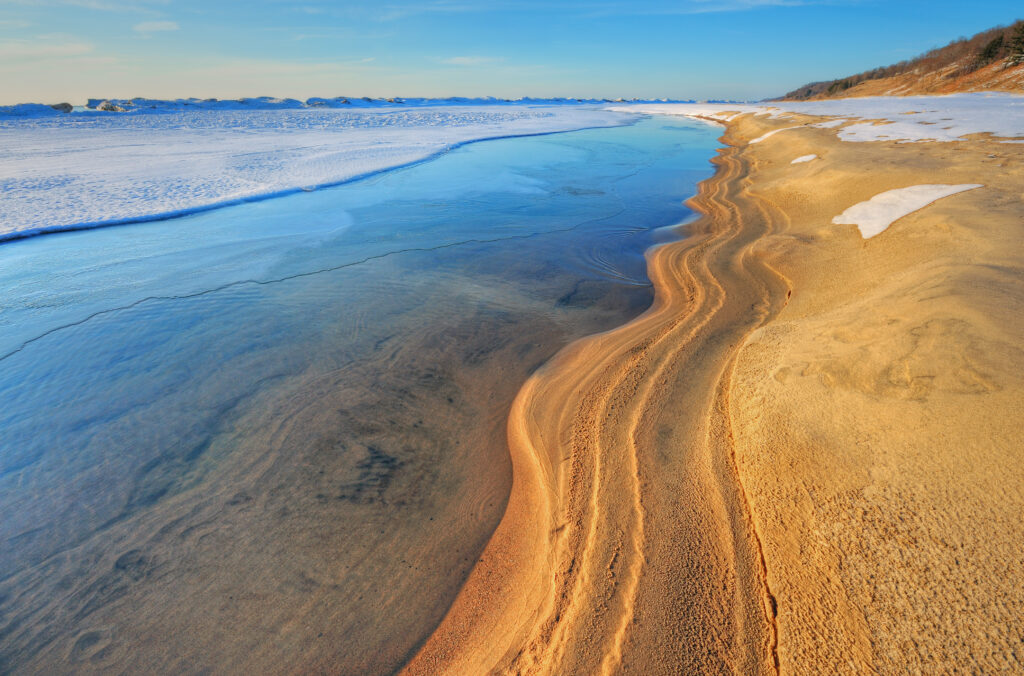
Downtown Saugatuck is vibrant with galleries, boutiques, cafés, and studios. The traditions of the Ox-Bow School of Art, affiliated with the School of the Art Institute of Chicago, give the town a creative foundation that still shapes its atmosphere. Artists paint en plein air along the riverbanks, and local galleries showcase a constantly changing tapestry of regional talent.
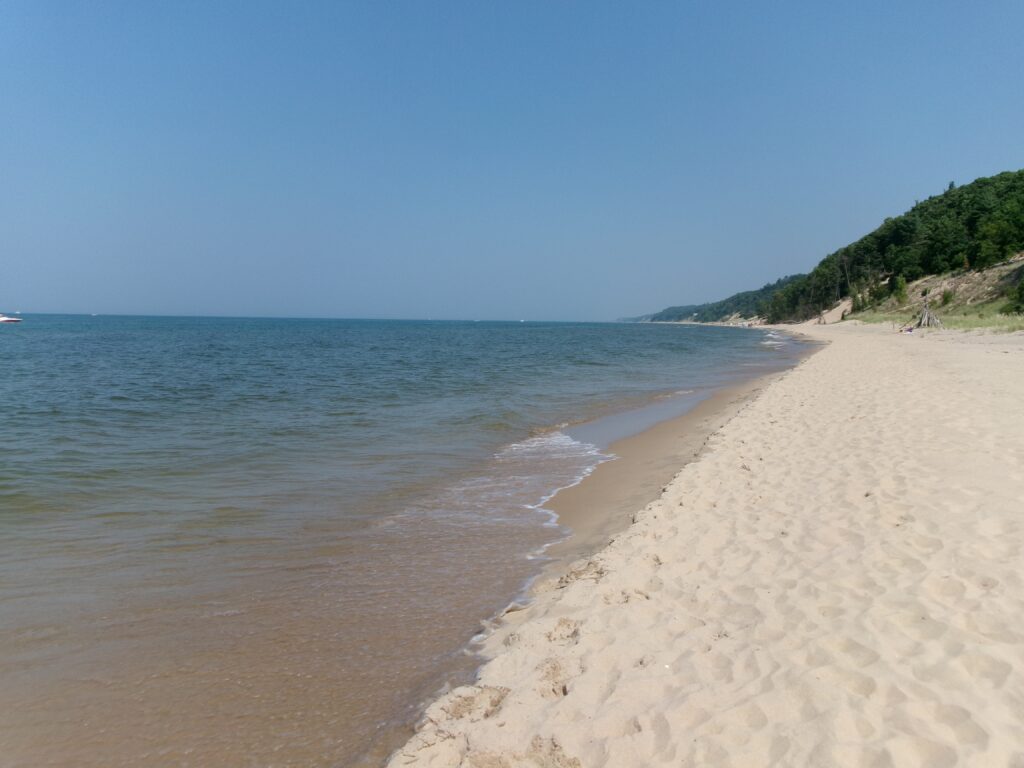
The natural scenery is equally compelling. Oval Beach, repeatedly named one of the best freshwater beaches in the world, offers soft sand, gentle waves, and sunsets that drench the sky in orange and violet. Nearby, the Saugatuck Dunes State Park is a sanctuary of towering hills, whispering pines, and winding trails that lead to secluded stretches of shoreline.
The towns have a relaxed elegance — upscale restaurants tucked beside old-fashioned ice-cream parlors, cozy bed-and-breakfasts shaded by maples, boats drifting down the Kalamazoo River toward the open lake. The chain ferry, one of the last hand-cranked ferries in the country, adds an endearing touch of heritage to the waterfront.
Saugatuck and Douglas embody the art of slow living: warm, colorful, creative, and gently bathed in lakeside light.
Marquette: Iron, Stone, and the Soul of the Upper Peninsula

Marquette is the unofficial capital of the Upper Peninsula — a city shaped by industry, wilderness, and the restless waters of Lake Superior. It is rugged yet warm, resilient yet creative, a place where iron ore docks tower like modern cathedrals and forest trails begin just beyond downtown. The air tastes cleaner here, touched by pine and the cool breath of the lake.

The city’s historic core — brick façades, old saloons reborn as cafés, breweries tucked into century-old buildings — blends heritage with youthful energy. Northern Michigan University infuses Marquette with an artistic, outdoors-minded spirit; murals decorate alleyways, and live music spills from local venues on summer evenings.
But the true magnetism of Marquette lies in its landscapes. Presque Isle Park, designed in part by Frederick Law Olmsted, curves into Superior like a protective arm. Its black basalt cliffs drop dramatically into deep blue water. Locals gather here to “jump the rocks,” diving into the lake in an act of bravery and tradition.
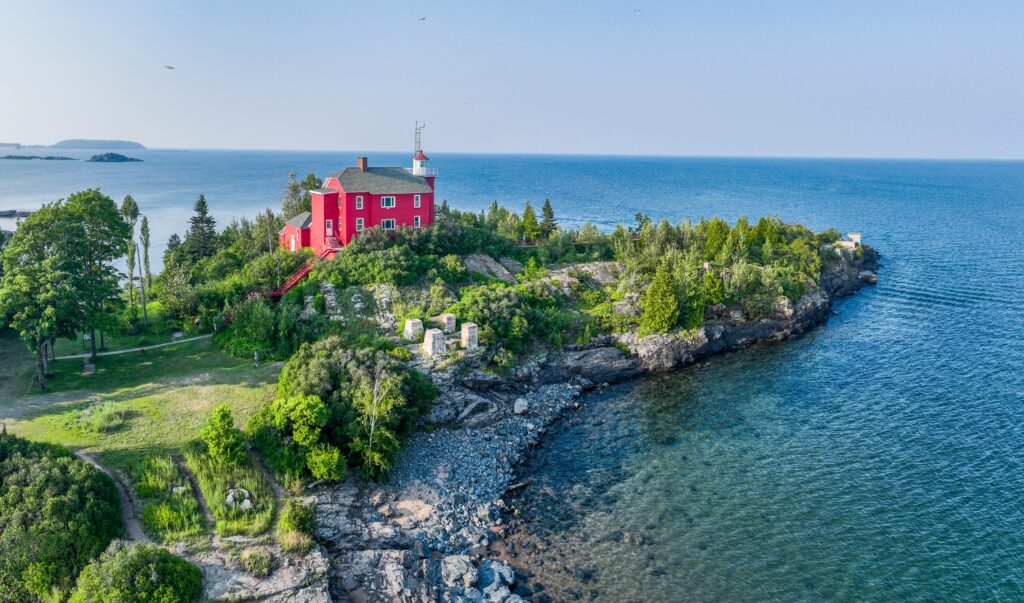
Nearby, the sandy arc of McCarty’s Cove invites swimmers and sunset-watchers. Trails wind up to Sugarloaf Mountain and Hogsback, where panoramic views stretch across forest and shoreline. In autumn, the hills blaze with color; in winter, snow transforms Marquette into a haven for cross-country skiing and fat-tire biking.
There is grit in Marquette — a working history of miners and Great Lakes sailors — but there is also poetry: quiet mornings with coffee on the harbor, slow walks along the breakwater, the haunting sound of fog horns drifting over the water. Marquette feels like a frontier city softened by artistry, a place where nature and community shape a rhythm all their own.
Mount Pleasant & the Chippewa River: The Heartbeat of Central Michigan
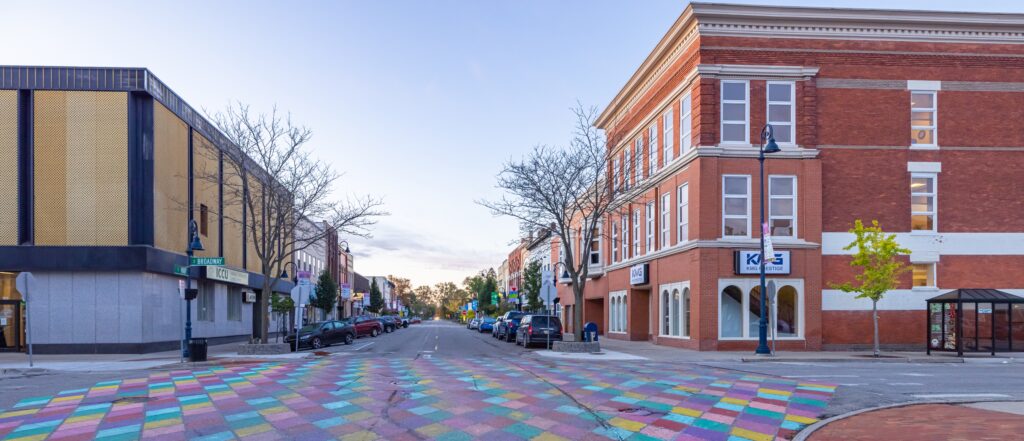
Set amid gentle farmland and wooded river corridors, Mount Pleasant feels like the calm center of Michigan — a place where the Chippewa River moves unhurriedly through town, and a sense of balance permeates daily life. Central Michigan University anchors the city, infusing it with a youthful spark and a steady flow of cultural energy.
Downtown Mount Pleasant is compact but lively. Independent cafés, small bakeries, and local restaurants cluster along the main streets, giving the town an intimate, neighborly feel. Art installations brighten public spaces, and community festivals bring residents together in easy, authentic celebration.

The Chippewa River is Mount Pleasant’s quiet treasure. Its waters are gentle enough for tubing, yet wild enough to attract kayakers and anglers seeking solitude. Oaks, maples, and willows line its banks, creating a green ribbon through the city. Summertime often sees families drifting downstream, sunlight flickering through the canopy.
North of town, the Soaring Eagle Casino & Resort adds a contrasting note of glitz and entertainment, offering concerts, gaming, and dining in a setting that draws visitors from across the state. The nearby Ziibiwing Center of Anishinabe Culture & Lifeways is one of Michigan’s most important Indigenous cultural institutions, honoring the history, stories, and spiritual traditions of the Saginaw Chippewa Indian Tribe with depth and dignity.
Mount Pleasant isn’t defined by grand drama or sweeping landscapes — its beauty lies in harmony, in the quiet interplay between community and nature. It is a place where the simple pleasures matter: a walk along the river, a warm conversation downtown, the golden silence of a fall morning over the fields.
Alpena & Thunder Bay: The Shipwreck Coast

Alpena stands along a quieter stretch of Lake Huron’s coastline — a region shaped by wind, water, and the echoes of maritime history. This is Michigan’s “Shipwreck Coast,” where dozens of vessels rest beneath the waves, preserved by cold freshwater and transformed into an underwater museum unlike any other in the United States.

The heart of this region is the Thunder Bay National Marine Sanctuary, a protected area where divers, kayakers, and glass-bottom boat tours can explore submerged wooden hulls, iron steamers, and ghostly silhouettes lying on the lakebed. These wrecks tell stories of storms, trade routes, and the rugged courage of sailors who braved the volatile Great Lakes.
On land, the Great Lakes Maritime Heritage Center offers a fascinating look at this nautical world, complete with life-size ship hulls and hands-on exhibits that bring the era of early shipping vividly to life.
Yet Alpena is more than shipwrecks. Its surrounding landscapes are tranquil and expansive: limestone cliffs, hidden coves, and quiet beaches where the water glows turquoise in the right light. Rockport State Recreation Area, just north of town, feels wild and untouched, with fossil fields, rugged shoreline, and deep forests rich with birdsong.
In town, a relaxed waterfront culture anchors daily life. Shops and cafés dot the streets; fishing boats drift out into the bay at dawn; and evenings often end with a stroll along the harbor as the sky shifts into lavender.
Alpena is contemplative, historical, and gently wild — a place that rewards curiosity and quiet exploration.
Charlevoix: A Town Between Lakes, Carved by Stone and Water

Charlevoix sits between two pristine bodies of water — Lake Michigan on one side, Lake Charlevoix on the other — giving the town a maritime charm that feels almost island-like. It is a place where sailboats skim across dual horizons, where the scent of freshwater drifts through the streets, and where landscapes alternate between manicured gardens and rugged shoreline.

One of Charlevoix’s signature features is its collection of mushroom houses, whimsical stone cottages designed by Earl Young. Their curved roofs, crooked chimneys, and undulating stonework make the neighborhoods feel like a fairy tale village tucked into the Michigan woods.
The downtown area looks out over the harbor, a scene filled with glossy boats, bustling cafés, and breezy waterfront promenades. In summer, the marina becomes a lively hub, with yachts and pleasure craft gliding through the channel as crowds gather to watch the dramatic opening of the lift bridge.
Fisherman’s Island State Park, just south of town, offers a wilder landscape: quiet beaches, emerald-colored shallows, and forests that seem to glow in late-afternoon light. Walking along its untouched shoreline feels like discovering a private corner of the Great Lakes.
Charlevoix is elegant, playful, and deeply scenic — a blend of architectural whimsy, lakeside beauty, and refined leisure. It is a place of perfect horizons and quiet magic.
Ludington: Dunes, Lighthouses, and the Pulse of Lake Michigan

Ludington is a coastal town where the wild side of Lake Michigan comes into full view. It is known for its sweeping dunes, historic lighthouses, and the iconic S.S. Badger, the last coal-fired passenger steamship operating in the United States. When the ship arrives or departs, its deep horn reverberates across the harbor like an echo from another age.

The centerpiece of this region is Ludington State Park, often considered one of Michigan’s finest parks. Trails weave through dunes, wetlands, and forests, connecting lakeshore beaches with the scenic Big Sable Point Lighthouse. The hike to the lighthouse is a rite of passage — miles of sand and waves ending at a towering black-and-white sentinel rising from the dunes.

Closer to town, Stearns Park Beach offers a more urban shoreline, where families gather, volleyball nets stretch across soft sand, and sunsets unfold in breathtaking color.
Ludington feels deeply connected to the elements. Winds whip across the beaches, fishing boats bob in the marina, and waves crash with thrilling force during autumn storms. Yet the town center is warm and welcoming, with ice cream shops, cafés, and independent stores adding small-town charm to this rugged coast.
Ludington is where nature’s power and community spirit meet, creating a destination that feels both adventurous and comforting.
The Hiawatha National Forest: Michigan’s Enchanted Wilderness

The Hiawatha National Forest stretches across the Upper Peninsula like a great green quilt, stitched together from deep forests, crystalline lakes, and quiet backroads. This is Michigan at its most enchanted — a land of mossy ground, whispering pines, and hidden paths that seem to lead into ancient stories.
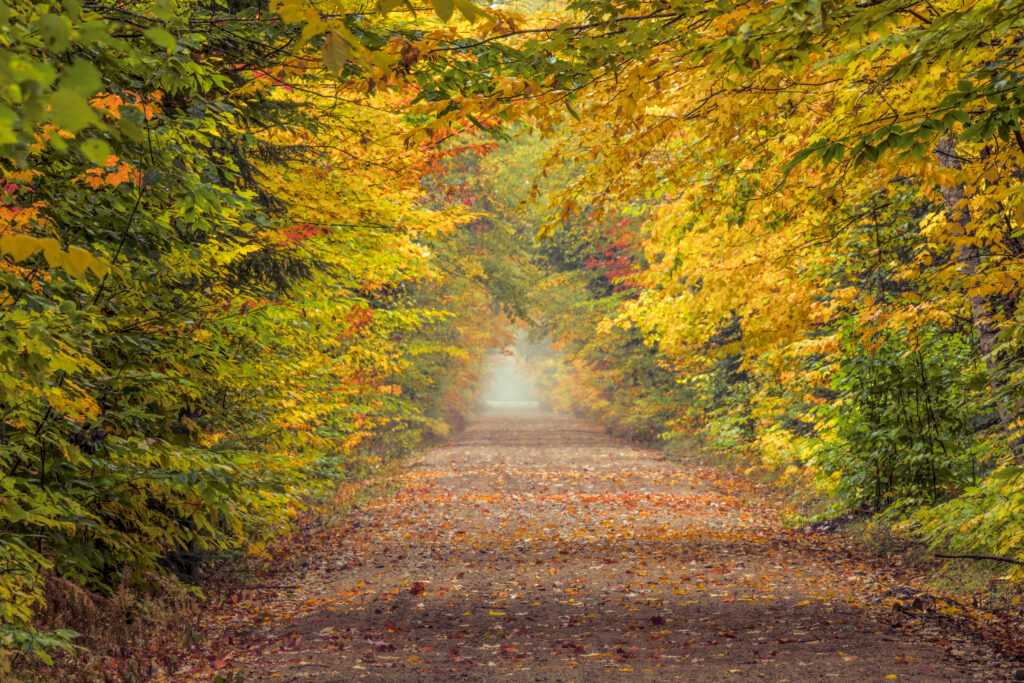
Here, the landscape feels untouched and timeless. Sunlight filters through towering white pines; loons call from mirror-like lakes; and tiny wildflowers bloom beside trails that wind through silence. The forest contains more than 100 lakes, their waters clear enough to reflect clouds with perfect clarity.
Throughout the Hiawatha, small recreation areas offer solitude without effort. Places like Bay Furnace Historic Site, Au Train Lake, and Little Bass Lake provide scenic launching points for hikes, paddles, and quiet contemplation. Wildlife is abundant — black bears, otters, eagles, and countless songbirds make their home here.

Along Lake Superior’s edge, the forest meets vast, rugged coastline. The beaches here are stony and quiet, the water icy and endlessly blue. Standing at the shore feels like stepping into a postcard from the northernmost wilderness.
The magic of the Hiawatha lies in its serenity. It is a place to slow down, breathe deeply, and rediscover the quiet pleasures of wild spaces. In a world that moves quickly, the Hiawatha National Forest offers a rare refuge — vast, green, and profoundly peaceful.

